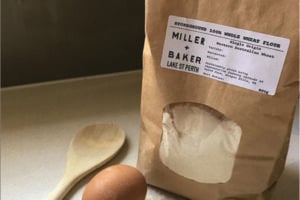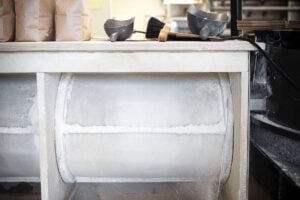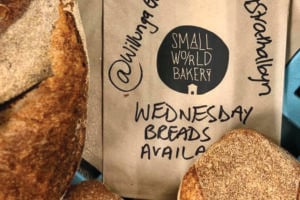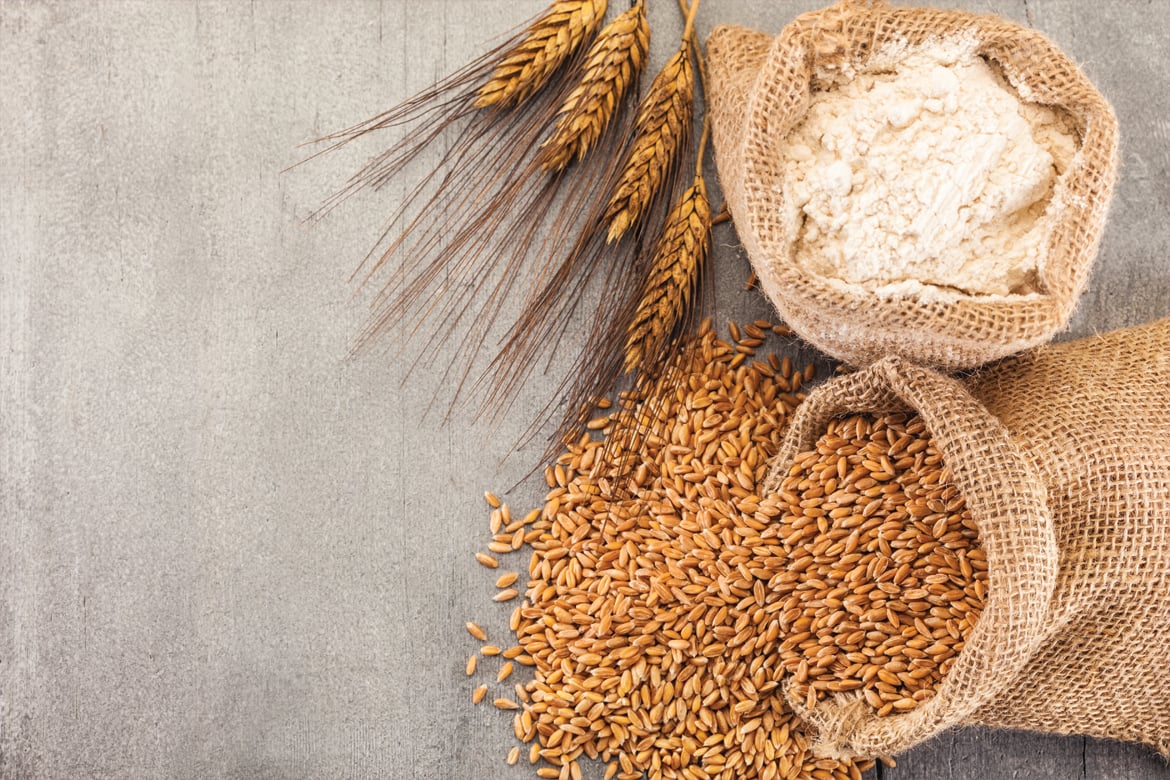On the whole, we’re seeing Australians trying to move to more sustainable ways of living, and that includes our bakeries. From using locally sourced ingredients in an effort to cut down their carbon footprint, to vegan product offerings, bakers are ensuring they can remain relevant and in touch with an ever-changing world. Perhaps the last frontier in the farm-to-plate movement, however, is milling your own flour. Here are just a few bakeries across the nation showing us how it’s done.
Miller + Baker, WA
Miller and owner of Perth’s Miller + Baker, Mark Taylor, was inspired by his time living abroad to mill his own flour, and has been doing so since opening last November. Every product sold at Miller + Baker contains freshly milled flour, with the goal being to slowly increase the percentage of house-milled flour until they’re only using their own.
“We lived in Denmark (Copenhagen) for a period of time a few years ago and we were spoilt with the most delicious tasting bread and pastries,” Mark says.
“We believe this was mostly down the quality of products used and the relationship the bakeries had with the farmers supplying the grain. Many Danish bakeries have a small mill onsite, or if not, they have a source of freshly milled flour.
“The taste was just one element but the health benefits are something we should take very seriously, as well as understanding how the grain is grown,” he explains.
“On returning to Perth my background in Environmental Science helped research and find some amazing and passionate farmers to source our grain. Ian and Di fully understood the importance of soil health plays in the quality of grains produced and the nutrients it provides.”


Using a New American Stone Mill, “a beautiful piece made of granite and steel”, Miller + Baker is milling every day to keep up their supply, as well as supplying their flour to a couple of neighbouring restaurants.
“Flour should be treated like all other food,” Mark says.
“Once it’s been processed (milled), its nutritional content diminishes – that’s why it should be used as soon as possible after milling. In our opinion, not only is it far better for you, the taste is far superior.
If he was to give advice to other bakers considering taking up the trade, Mark says the key is finding the right farmers and connecting with the network of miller-bakers.
“There is an untapped network of farmers and other producers who are really passionate about growing sustainable and earth conscious product but getting their product into even their own local market has proven difficult for them,” he says.
“Their products are of the highest quality and believe local people should have the chance to be able to buy it.
“It’s time to rethink how we do things. Using freshly milled, great quality locally sourced grains for bread production in my mind makes perfect sense. It might take a little bit more effort but the benefits far outweigh the extra effort involved.
“We are so excited by the growing movement towards a sustainable local grain economy.”
Staple Bakery, NSW
Owner and baker at Sydney’s Staple Bakery, James Partington, has been milling his own flour for a year now and hasn’t looked back. Also using a New American Stone Mill, James says that they mill around 40 per cent of their own flour for their bread and pastry production.
“The main portion goes into our breads – some have 100 per cent freshly-milled (milled within 24 hours or same day),” he says.
“We make a rye that’s 100 per cent freshly milled with rye chops as well, and we do our signature Miche loaf – that’s wheat, spelt and rye and from mill to mix to shape to bake and on the racks it’s seven hours at the most.


“We also mill freshly-milled wheat and rye for our rough puff pastry – this adds a whole new flavour profile.”
James can be found milling most days, although sometimes he does larger batches depending on how much time he has.
“The difference between freshly-milled flour and flour from a mill is like night and day,” he says.
“Now, I can mill great flour, but to start with it was just okay. There are proven health benefits to freshly-milled and also flavour. The aroma, the feel and the way it responds to our process is really special.
“When I first considered a stone mill, many people (bakers, millers, famers etc.) all said it was a whole new skillset I would have to learn and take up too much time. Sure, it did take some time to get to know how to treat different grains and flow rates, but after three-six months I was pretty competent and producing flour regularly on par with flour bought from a mill.
“Milling now takes me three-five minutes to set up and then I run the mill for anything from 20 mins to three hours depending on the grain. I’ve also re-dressed the stones and that wasn’t too arduous, and now the flour is better than ever!”
Dust, space, grain supply and storage are all things James says you need to consider before taking up milling, but to anyone thinking about getting a mill – benchtop or otherwise – he says “do it!”
Small World Bakery, SA
Emily Salkeld and Chris Duffy are a husband and wife team who co-own Small World Bakery in Langhorne Creek. They’ve been using a natural granite stone mill – also the New American – to mill their own flour for over two years, gradually increasing the proportion of in-house milled flour over that time.
“We make all our own flour,” Emily says.
“We buy wheat, rye and spelt grain from Victoria and South Australia and clean, bag and store on site. All this equipment has taken some time and effort to secure, as it’s small scale and some of it imported.
“Chris is milling almost every day now that we are using about 600kg per week in the bakery.”


Emily says the difference freshly-milled flour makes to their bakery products makes the extra effort and time worth it.
“The aromas and flavours from using freshly-milled flour are perfectly captured in all the baked products we make,” she explains.
“When we stone mill grain we manage to retain every fraction of a highly nutritious seed in our whole flours, and most of it in the sifted flour. By this, I’m referring to the oil and mineral rich germ, and the bran and aleurone layers on the outside of the grain which are usually effectively removed in a roller milling facility.
“Retaining the germ and bran fractions lends delicious flavours, but also reduces the shelf life of the flour. It needs to be kept cool and used sooner rather than later, which again emphasises that stone milled flour is a fresh food.”
Emily says that the enhanced overall quality in their flour and breads helps them to get the message across to their customers about their work to build a viable localised food system in the region.
“The flavour in our breads stops customers in their tracks and leads them to think more about a pretty ubiquitous and identity- free food,” she says.
“Maybe flour is the last frontier in the paddock to plate movement!”
Three Mills Bakery, ACT
Owner of Three Mills Bakery in the ACT, Jarrod Deaton, and Head Baker James McAuliffe have a lot of experience milling, having been doing it since 2013. Using two small stone mills, they spend several hours each day milling rye, which they use a 1/10th of the flour in most of their sourdough, and wheat which they use in their culture (which in turn is then used in all of their starters).
They say that using their own house-milled flour has many benefits which makes those extra hours of work worth it.
“The fresh wheat really helps our starter to thrive through various environmental conditions and production challenges,” they say.
“We also enjoy the additional nutritional benefits available when using grains that have been freshly milled.”


Additionally, they say, uncommon varieties of grain are more available in whole kernel form.
“By having the ability to mill our own, it means we can access these small batch grains and create really unique loaves.
“In our world, there’s no substitute for freshly milled whole grain flour. However, for the home baker it may not be practical to mill what you need in order to achieve the results it offers. In addition, freshly-milled flour does behave a little differently and can give you unusual results. As an alternative you could find a quality stone ground, whole grain flour and add unique (soaked) grains at the end of the mix.
“Remember to keep your freshly milled flour in the fridge to better preserve the essential oils.”




COMMENTS